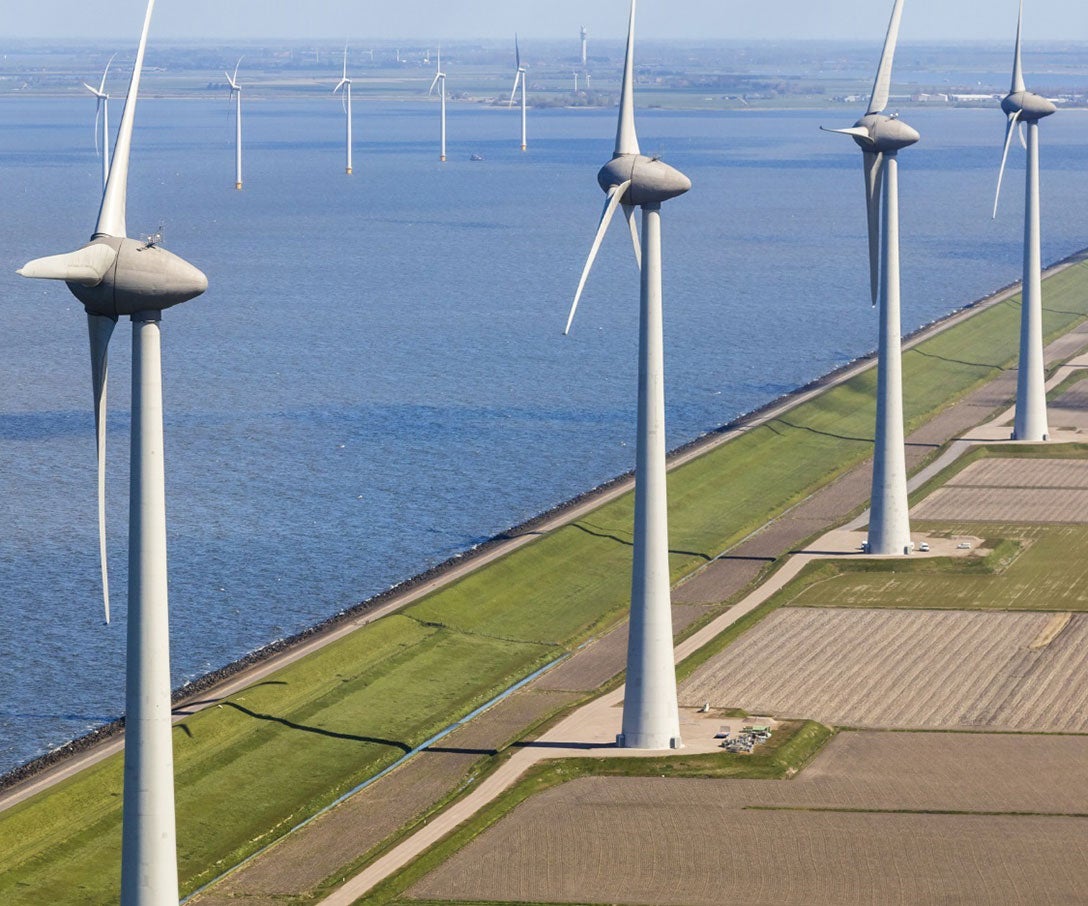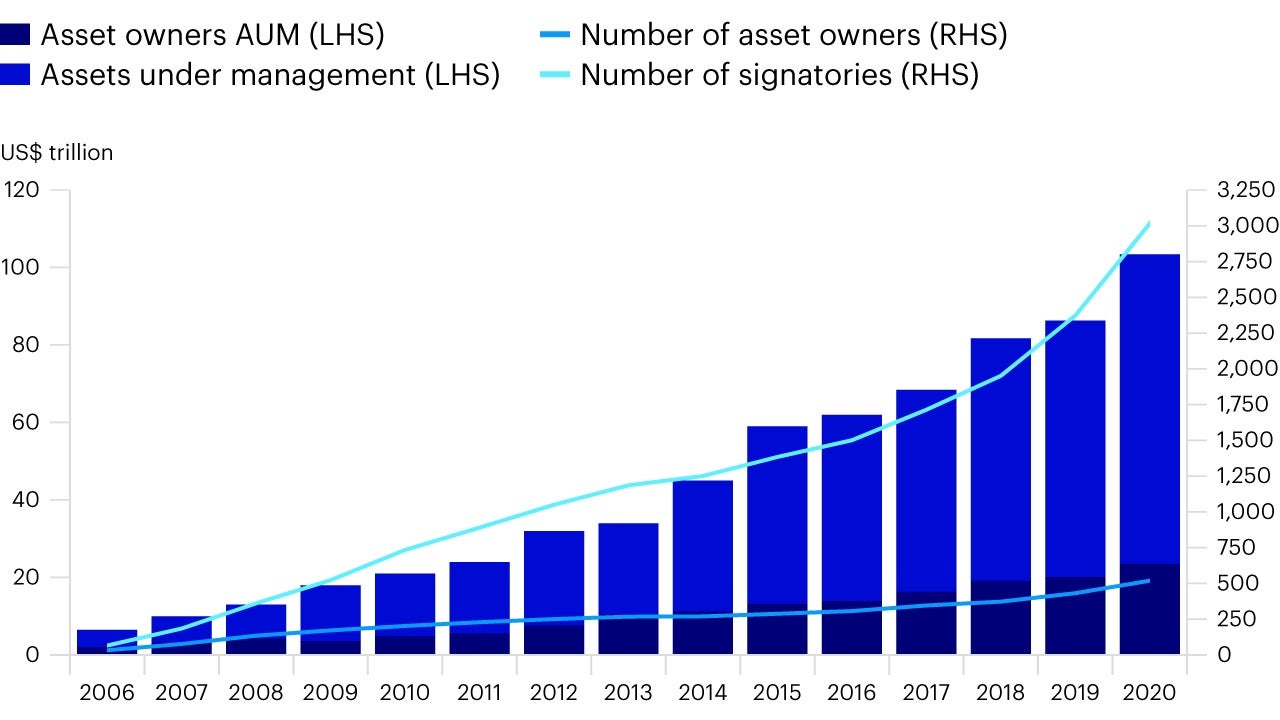Understanding ESG Part 1: The rise of responsible investing and ESG

Asset managers and their clients are increasingly incorporating environmental, social and governance considerations – collectively known as ESG – into their investment decisions. This reflects the spectacular rise of responsible investing – an investment ethos that can deliver benefits beyond the bottom line and recognises that modern-day investment should be a matter of long-term ownership and sound stewardship.
In this article we explore what responsible investing really means, examine its journey into the mainstream and explain why the phenomenon is only likely to become more important and impactful in the years and decades ahead. We also provide some examples of responsible investing in action, showing how the ESG-aware allocation of capital is making a positive and lasting difference to the wider world and why such an approach is fast becoming the norm for all of Invesco’s products and services.
What is responsible investing?
Responsible investing is arguably the most important investment trend of recent decades. The idea is not entirely novel, but it has never been as sophisticated, as popular or as effective as it is today. Once a “nice-to-have”, it is now frequently seen as a “must-have”. It is rapidly transitioning from the margins to the mainstream and is increasingly regarded as a vital component of investment thinking.
The term “responsible investing” encompasses products and services that reflect a major shift in the focus of businesses, entities and society in general. We might usefully think of this shift as a move from the long-established model of shareholder capitalism, in which success is measured in profits alone, to what is sometimes known as stakeholder capitalism, in which the desire for attractive returns goes hand in hand with a determination to serve the greater good.
Business Roundtable, an association of CEOs of leading companies in the US, underlined the extent and significance of this continuing transformation in a landmark statement in August 2019. Historically, the organisation advocated “shareholder primacy1” in outlining the purpose of a corporation. It now emphasises a company’s commitment to benefiting all stakeholders – including customers, employees, suppliers and communities.
Such an outlook is found on a genuinely global level in the United Nations Sustainable Development Goals (UN SDGs), as shown below. Launched in 2015 and described by the UN as “a shared blueprint for peace and prosperity”, the 17 SDGs encapsulate the key issues facing our planet and its inhabitants. From age-old blights such as poverty and inequality to all-pervading existential threats such as climate change, these are concerns that responsible investing attempts to address.
In sum, then, responsible investing seeks to combine investment performance with objectives that extend beyond the bottom line. It is about “doing the right thing”, encouraging sustainability and contributing to positive, lasting change. By allocating capital as productively as possible and meeting long-term needs rather than chasing short-term gain, it allows investors to play their part in tackling the biggest challenges of our era – and those of the eras still to come.

Source: United Nations.
Responsible investing is about ‘doing the right thing’, encouraging sustainability and contributing to positive, lasting change.
A brief history of responsible investing
As remarked above, responsible investing is not a new concept. Jewish and Islamic law imposed ethical constraints on investments millennia ago, and faith-based investors of many kinds – Quakers and Methodists, for example – have a long tradition of avoiding sectors not in keeping with their convictions.
It could be said that responsible investing is as old as lending, given that even the earliest lenders may have wanted to avoid what are now sometimes described as “negative externalities” – the costs or disadvantages imposed on unwitting third parties. Arthur Cecil Pigou, a Professor of Political Economy at the University of Cambridge, developed this notion in the 1920s, shedding fresh light on the relationship between companies and society and showing that business activity can have both welcome and unwelcome consequences.
Responsible investing as we know it today first became formalised in the 1960s, when some shareholders began to grasp their ability to influence corporate behaviour. Later in the second half of the 20th century, thanks to a series of high-profile catastrophes, the links between companies’ conduct and real-world repercussions became all too clear. Incidents such as the Bhopal industrial disaster and the Exxon Valdez oil spillage underscored the value of corporate social responsibility and reinforced the emerging belief that investors should share the blame whenever a business fails to meet its basic obligations to society at large.
Environmental issues in particular started to shape many investors’ thinking, especially in light of climate change and mounting scientific evidence of the far-reaching damage caused by CO2 emissions. In due course, not least in the wake of the global financial crisis, the importance of social and governance factors also entered the reckoning. Gradually – and rightly – investment came to be framed as a matter of long-term ownership and sound stewardship.
The marked rise of responsible investing in recent years is strikingly illustrated by data from the Principles for Responsible Investment (PRI), a UN-backed international network whose signatories – including Invesco – now have more than $100 trillion in assets under management. Today, as shown below, PRI membership is growing more quickly than ever – proving beyond question responsible investing’s journey from fringe consideration to essential cornerstone.

Gradually – and rightly – investment came to be framed as a matter of long-term ownership and sound stewardship.
Why is responsible investing’s rise likely to continue?
There are many reasons to believe that responsible investing is set to become a “new normal”. They include its proven positive impact on corporate financial performance; the greater availability of data; heightened awareness of related opportunities and risks; policymaking and regulatory focus; and public and investor sentiment. Let us briefly look at each in turn.
The debate over whether it “pays to be good” raged for several decades, with opponents of responsible investing maintaining that such a philosophy narrowed the investment universe and dented returns. Today a wealth of research indicates that the opposite is true. It is now widely acknowledged that businesses are more likely to outperform over the longer term if they take account of environmental, social and governance issues.
Crucially, thanks to the quantity and quality of available data, the risk/return trade-offs involved in responsible investing are now much better understood. Academic studies, improved transparency, enhanced disclosure and the more refined use of factors – quantifiable characteristics that can help clarify patterns of risk and return across asset classes – all strengthen the case for a sustainable, long-term approach. It is accepted that responsible investing can be a source of opportunity – and that irresponsible investing can entail a variety of material risks.
We have already seen how responsible investing mirrors the aims enshrined in the UN SDGs. It is also central to achieving the objectives set out in the Paris Agreement on climate change and other milestone initiatives. In addition, ambitious regulatory roadmaps such as the European Green Deal and the EU Sustainable Finance Action Plan expressly require businesses and investors alike to take a responsible route – or at least to explain their disinclination to do so. There is not only high-level backing for responsible investing: there is also high-level pressure to embrace it.
And investors are embracing it. They want to make a difference. How capital is allocated today increasingly ties in with broader public opinion, most notably among younger generations. As shown below, millennials are overwhelmingly in favour of responsible investing – lending further weight to the conclusion that such an approach is likely to define the way ahead.
Millennials as a key driver of responsible investing’s continued rise
95%
89%
88%
57%
$30 trillion
Source: MSCI: Swipe to Invest: the Story Behind Millennials and ESG Investing, 2020; Accenture: The “Greater” Wealth Transfer: Capitalising on the Intergenerational Shift in Wealth, 2012; Bank of America: 2018 Insights on Wealth and Worth, 2018; Allianz: Allianz ESG Investor Sentiment Study 2019, 2019; Morgan Stanley: Sustainable Signals: the Individual Investor Perspective, 2019.
It is accepted that responsible investing can be a source of opportunity – and that irresponsible investing can entail a variety of material risks.
A closer look at ESG
We have highlighted on several occasions the growing importance that many investors now attach to environmental, social and governance issues. As noted in the introduction to this article, these considerations are collectively known as ESG. Here we examine each of the three components and draw on examples of their application to demonstrate how ESG inputs can translate into real-world outcomes.
ESG criteria constitute a set of standards used to measure how responsibly a business or some other form of entity operates. There is now an abundance of data that can help gauge performance in this regard, as observed earlier, while direct engagement and dialogue can further inform investment decisions. Broadly speaking, responsible investors look to invest in companies that are already proactive in their attitudes to ESG or which are capable and/or willing to adopt such an approach.
Environmental
considerations tend to dominate many investors’ ESG thinking. This is unsurprising, given the wide-ranging effects of climate change – which, even in the era of COVID-19, remains the biggest existential threat of our age. In assessing an organisation’s environmental performance, we might take into account factors such as the use of natural resources, supply-chain impact and policies around pollution and waste.
Social
considerations cover how an organisation interacts with stakeholders, clients, employees, suppliers, communities and, vitally, society as a whole. It has traditionally been the least prominent of ESG’s three elements, although it is now gaining ground. Here we might take into account factors such as workforce and community relations, human rights and polices around equality.
Governance
considerations might reasonably be thought of as the bedrock of ESG, in so far as an organisation’s commitment to E and S must to some extent stem from its commitment to G. Management, board composition, auditing practices, regulatory concerns, compensation and corruption are among the factors taken into account here, as is the overarching theme of corporate social responsibility. Governance is perhaps the fundamental yardstick of how an organisation aligns its own interests with those of multiple stakeholders.
Real-world application: from ESG inputs to positive outcomes
Environmental
In 2019 the first of the “big six” UK energy suppliers succeeded in switching all of its electricity customers to renewable electricity – at no extra cost. Investing in a forward-thinking company such as this can help achieve UN SDGs such as the following:
- 7 – Affordable and clean energy
- 9 – Industry, innovation and infrastructure
- 11 – Sustainable cities and communities
- 13 – Climate action
Social
In 2020 Invesco worked with a leading socially responsible bank in the US, to create a bespoke investment platform. The bank provides resources for non-profits, unions, political organisations, social impact enterprises and other entities committed to equality. This collaboration can help achieve UN SDGs such as the following:
- 1 – No poverty
- 3 – Good health and wellbeing
- 8 – Decent work and economic growth
- 10 – Reduced inequalities
Governance
Each year Invesco participates in thousands of proxy votes at investee companies’ annual general meetings. Most pertain to governance matters such as executive remuneration, board membership and corporate policies and practices. In 2018 alone we voted at more than 18,500 meetings in 74 markets. Encouraging good governance can help achieve UN SDGs such as the following:
- 5 – Gender equality
- 8 – Decent work and economic growth
- 10 – Reduced inequalities
- 12 – Responsible consumption and production
ESG criteria constitute a set of standards used to measure how responsibly a business or some other form of entity operates.
Conclusion
In this article we have outlined some of the key basics of responsible investing and ESG. Above all, what should be clear is that this is a phenomenon that is having an ever-greater influence on investors’ thinking. There can be little doubt that the desire to make a positive, lasting difference through the responsible allocation of capital has become one of the defining investment stories of our time.
Going forward, the integration of ESG considerations into investment decisions is likely to become ever more widespread and ever more sophisticated. We will explore this in more detail in our next article.
Source
-
1. A shareholder-centric form of corporate governance that focuses on maximising the value to shareholders before the interests of other corporate stakeholders.
Investment risks
-
For complete information on risks, refer to the legal documents.
The value of investments and any income will fluctuate (this may partly be the result of exchange rate fluctuations) and investors may not get back the full amount invested.
Important information
-
This marketing communication is exclusively for use by professional investors in Portugal. It is not intended for and should not be distributed to the public. Investors should read the legal documents prior to investing.
Data as at 27 September 2023, unless otherwise stated.
By accepting this material, you consent to communicate with us in English, unless you inform us otherwise.
This is marketing material and not financial advice. It is not intended as a recommendation to buy or sell any particular asset class, security or strategy. Regulatory requirements that require impartiality of investment/investment strategy recommendations are therefore not applicable nor are any prohibitions to trade before publication.
Views and opinions are based on current market conditions and are subject to change.
Invesco Management S.A., President Building, 37A Avenue JF Kennedy, L-1855 Luxembourg, regulated by the Commission de Surveillance du Secteur Financier, Luxembourg.EMEA3136756/2023

